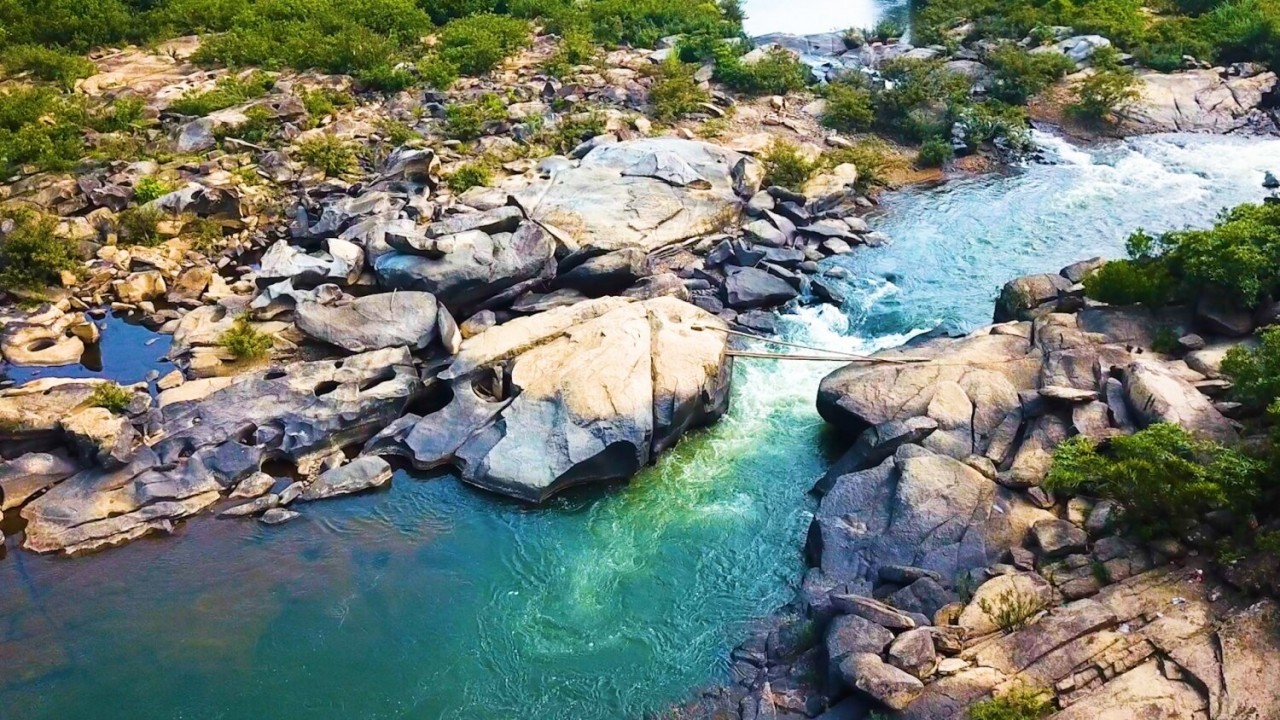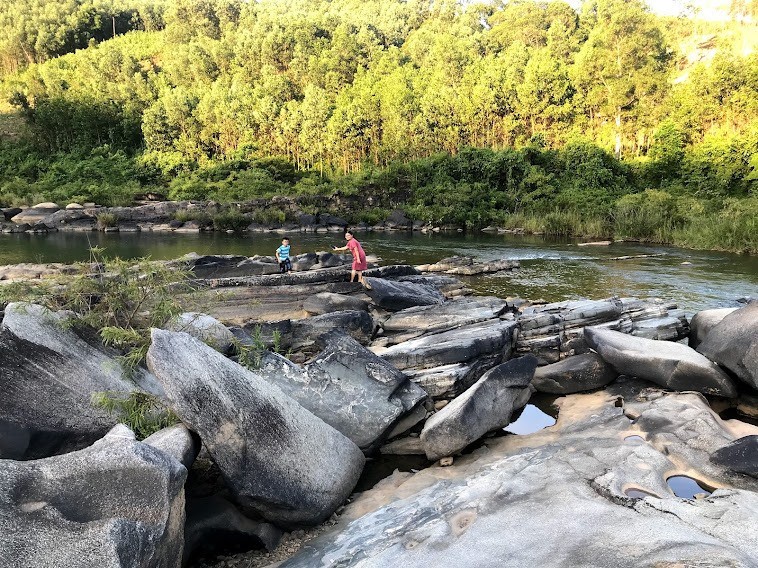The Lo Thung rock pool, which stretches over the Tien Canh and Tien An communes of the Tien Phuoc District, is surrounded by mountain ranges renowned in central Vietnam. The rock pool is located on the bank of the Da Giang River, a tributary of the Tien River.
This tourist destination, situated near Hoi An, boasts a captivating natural landscape that remains untouched and pristine. It is often referred to as a “stone kingdom” and draws numerous tourists to Quang Nam.
 |
| This tourist destination near Hoi An has a charming natural landscape, pristine and untouched by humans. Photo: VTCNews |
According to local folklore, a giant god visited this location to assist the people with land reclamation. During his journey, he dropped the rocks he was carrying into the Da Giang River, forming the Lo Thung rock pool. The indentations on the stones are believed to be the god’s footprints.
The rocky shoreline consists of large and small, undulating, thick rocks of diverse shapes and forms. There are flat slabs resembling carved panels and sections of rock that are oddly jagged and rugged.
In 1964, during a severe flood, locals reported hearing thunderous rumbling akin to bomb explosions at midnight. Upon daybreak, they discovered numerous large stones scattered and broken in the surrounding areas.
To reach the most substantial stones at the rock pool, visitors must wade through knee-deep water.
 |
| Folk legend says that in the past, a giant god came to this place to help people open up and reclaim land. Photo: VTCNews |
A notable highlight of Lo Thung is its “water cave,” where visitors can observe rocks of various shapes. Some stand solitary, while others are stacked upon each other.
Several of the rocks are large enough to accommodate tourists, providing them with a place to rest and admire the breathtaking views of nature, where rivers, mountains, and the azure sky merge to paint a magnificent canvas.
Tiny stones amidst the rock pool serve as a fertile ground for grass and wildflowers, forming captivating natural rock gardens.
Tourists are advised to visit the Lo Thung Tien Canh Tien Phuoc at two of the most picturesque times of the day: sunrise and sunset. Similar to Hon Kem Da Dung, this site retains its unspoiled, natural state, unaffected by human intervention. It is an ideal destination for those seeking a relaxing weekend getaway.
After swimming in the river, visitors can bask in the radiant glow of the yellow dunes, enhancing their experience of Lo Thung’s untamed beauty.
 |
| At the rock pool, grass and wildflowers grow well between small stones, and form attractive natural rock gardens. Photo: VTCNews |
A visit to the Lo Thung rock pool not only offers breathtaking natural scenery but also an opportunity to savor the culinary delights of Hoi An and Quang Nam, including stir-fried stone snails, grilled Nien fish, mixed jackfruit, bee porridge, salt stewed chicken, and grilled chicken.
Quang Nam is a province situated in the South Central Coast region of Vietnam. Blessed with a strategic location adjacent to the sea, Quang Nam boasts numerous stunning beaches. Furthermore, as the home of two UNESCO World Heritage sites, Hoi An Ancient Town and My Son Sanctuary, Quang Nam proudly preserves the unique Champa culture and the cultural exchange with the outside world. Thanks to its natural resources and distinct culture, Quang Nam attracts domestic and international tourists alike.
 |
| Several of the rocks are big enough for tourists to rest on. Photo: Bao Quang Nam |
Quang Nam experiences two distinct seasons: the rainy season and the dry season. During the rainy season (from September to December), storms and flash floods are prevalent, which may impact travel plans. Consequently, the ideal time for tourists to visit Quang Nam is from April to August.
For those planning to incorporate Hoi An into their Quang Nam itinerary, it is recommended to arrange their visit to coincide with the 14th day of the lunar calendar each month, particularly during the Mid-Autumn Festival. On this special day, locals celebrate with a nighttime festival, illuminating the Hoai River with a dazzling array of golden lanterns.



